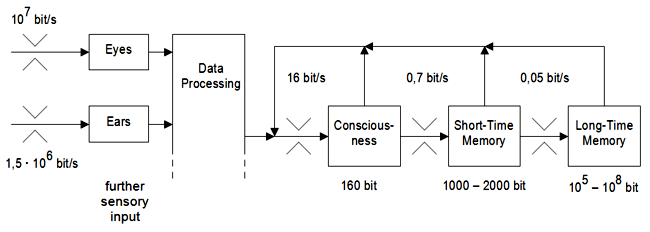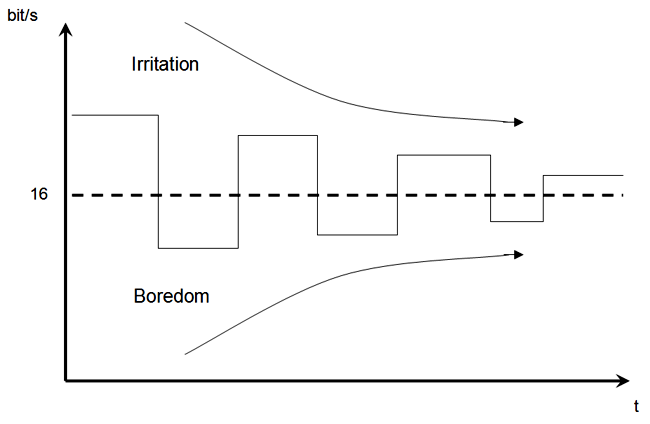 - Wissenschaft & Kunst (Science & Art) -
- Wissenschaft & Kunst (Science & Art) -  - Wissenschaft & Kunst (Science & Art) -
- Wissenschaft & Kunst (Science & Art) -
|
by
|
||||
Every work of art stimulates perceptual processes in the observer, listener, or reader.
A cohesive conceptualization of fine art, music, literature, etc., requires that they share common characteristic properties.
One such similarity lies in the fact that these products are all absorbed through perception.
The rules that govern perception must also be valid for the consumption of art,
and it would therefore make sense to research whether characteristic properties of art can be differentiated.
 Diagram 1: The schema of conscious data processing Naturally, one understands that the brain and sensory organs function on a physical basis, that perception itself is above all a product of data processing. This of course depends on the filtering of useful information from the multitude of incoming stimuli. This process can be broken down into many pieces, such as analysis, filtering, and decoding of included information, whereby the large data pool is dramatically reduced. A large part of this goes on to the subconscious center, in which reflexes are stimulated, such as control of body movements. Consciousness, which can be seen as the main memory, receives only a small part of the data that because of special distinguishing features, such as ones innovative character, are recognized as especially important. Now begins the last and most complicated step of the analysis - the one to be consciously executed. Known strategies of thought are enlisted, especially with the help of previous knowledge. In this way - stimulated by association, contents from short-term and long-term memory are recalled. Like every technical data processing system, the neural net is also subjected to finite physical restrictions, such as limited work speed that results from limited memory and the capacity of information flow. In the diagram are given the largest values of the human brain; these are values that come from psychological testing. A fundamental result is that a human can only consciously absorb around 16 bits per second, and that the apparent contents are not capable of displaying more than around 160 bits. On average, these values are calculated so that one can grasp the impression of the complexity of the environment. The complexity of the registered patterns can over burden the system; this shows that with the help of definite methods, such as those based on approximations or probabilities, useable results are often produced. When one sees the benefits of the goal of an overview of the situations, problems, etc. then the complexity of the situation can be reduced to 160 bits. Occasionally a person comes up against an information source that offers a flow of information, in which the complexity is in perfect agreement with the abilities of the processing system. Such patterns or stimuli are seen to be pleasing. It is also possible to purposely conceptualize an information stream such that the described ideal preconditions correspond to the reception of information. Such information streams are seen as works of art.  Diagram 2: Control of cognitive behaviors through emotion People's cognitively achievable actions are realized through emotion. There are, in consciousness, acute signals that are critical for survival. There are pleasing emotions that lead to the perpetuation of a situation, and other unpleasant emotions, that serve as an impetus for avoidance. The emotions dedicated to perceptive assimilation are as follows: Boredom, when fewer than ~16 bits/sec come into consciousness - - they stir a search for a productive source of information; Irritation, when more than ~16 bits/sec are received - - then one attempts to comprehend through increased concentration, or, if one is unsuccessful, abandons the information source; Interest, when one receives ~16 bits/sec - - the situation is felt to be desirable. This formula of action gives us an explanation of one's emotional function when confronted with a work of art. So works of art - as defined above - are so structured as to evoke a successful perceptual response, awaken interest, and stimulate the appropriate emotions of perceptual behavior. FAQs Where do the given values of data capacity come from? - These are the results from a series of tests of perceptual psychology and learning theory that were done in the 60s. Similar research comes from earlier periods, and were first translated later in the Shannon Information, whereby their general validity emerged. In the meantime they have been confirmed and refined through further research. Are the details of the standard capacity of the human brain exact enough to draw extensive conclusions? - Pertaining to art, sufficient approximations need only agree within an order of magnitude. The functional pattern remains the same. With art forms in which perceptual content changes over time, the 16 bit rule can be used. How does it behave in unchangeable art forms, such as images? - Complex images are scanned according to a specific pattern, so the 16 bit rule still applies. Are both interpretations of patterns valid for every art form? - The derived rules are commensurate to the extent of the classic concept of art, where the perception of beauty plays a role, and also in so far as an explanation of modern art is necessary, as one can explain in which respect these depart from the classic paradigm. With respect to aesthetic effects, is coherence of mind taken into consideration? - It is known that associative catalytic elements give rise to different emotions, which are specifically used in communication. That memory capacity must be expended for the coding of semantic elements, such as words, also applies to the schema of data processing. For what does one need a complicated structuring of artwork, such that any emotions can be stimulated by associative elements? - "Works of Art", which depend solely on the associative stimulation of feeling, but are insufficiently structured, will have a minimal impact. Such works of lower complexity are considered "Kitsch". Which strategies are to be applied in order to process works of high complexity, as well as those than overextend the 160 bit capacity of awareness? - There are many strategies. One can search for efficient codings, for example with the help of memory recall, or one can split the situation into component parts and deal with each in succession. The most comfortable solution is to arbitrarily simplify the situation (a method that often leads to misunderstandings, pseudoknowledge, and the like). How does the artist present his work without using information theory to properly structure it? - Not only the artist, but every person has learned in life how to prepare his conversational partner so that his presentation will be understood. In difficult cases, the artist, in between specific work phases, puts himself in the place of the audience on a trial basis, or he displays his work to a knowledgeable colleague before its release. For the rest, the declared worth need not be heeded, as the observer, listener, or reader can, within certain limitations, ascribe excess worth or experience boredom (as unfortunately is often the case in art exhibitions). Why does an audience find pleasure in a work of art, even after several presentations? - This question is especially warranted in the case of images, because according to theory, people should be interested for only ten seconds in a properly structured image - that is one that can be reduced to 160 bits of information. Here the artist must apply special strategies in order to hold the audiences' interest for a longer time. There are many possible methods for this. The most important is based upon the fact that the person is capable of concentrating on the presented information at multiple levels of meaning. Only when every condition is configured in accordance with optimal perception can he concentrate on each individual presentation, and can discover what was previously unnoticed, to which he attributes meaning. The underlying idea, designated the "multi-layered model", offers further basic assistance in the explanation of the provocative impact of art. With this help it is possible to classify discrete art forms according to their level of impact. Further questions regarding the fundamental issues of information-based psychological models of art merit a more thorough treatment. This can be found in my book 'Einführung in die kybernetische Ästhetik' ('Introduction to the Cybernetic Aesthetics'), which has so far appeared in German and Spanish, but not yet in English. |
||||